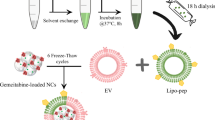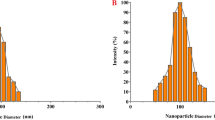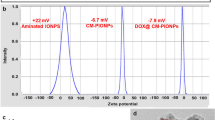Abstract
Pancreatic cancer remains one of the most lethal cancers largely due to the inefficient delivery of therapeutics. Nanomaterials have been extensively investigated as drug delivery platforms, showing improved drug pharmacodynamics and pharmacokinetics. However, their applications in pancreatic cancer have not yet been successful due to limited tumor delivery caused by dense tumor stroma and distorted tumor vasculatures. Meanwhile, smaller-sized nanomaterials have shown improved tumor delivery and retention in various tumors, including pancreatic tumors, suggesting their potential in enhancing drug delivery. An ultrafine iron oxide nanoparticle (uIONP) was used to encapsulate 7-ethyl-10-hydroxyl camptothecin (SN38), the water-insoluble active metabolite of pancreatic cancer chemotherapy drug irinotecan. Insulin-like growth factor 1 (IGF-1) was conjugated to uIONP as a ligand for targeting pancreatic cancer cells overexpressing IGF-1 receptor (IGF1R). The SN38 loading and release profile were characterized. The pancreatic cancer cell targeting using IGF1-uIONP/SN38 and subsequently induced cell apoptosis were also investigated. IGF1-uIONP/SN38 demonstrated a stable drug loading in physiological pH with the loading efficiency of 68.2 ± 3.5% (SN38/Fe, wt%) and < 7% release for 24 h. In tumor-interstitial- and lysosomal-mimicking pH (6.5 and 5.5), 52.2 and 91.3% of encapsulated SN38 were released over 24 h. The IGF1-uIONP/SN38 exhibited specific receptor-mediated cell targeting and cytotoxicity Ato MiaPaCa-2 and Panc02 pancreatic cancer cells with IC50 of 11.8 ± 2.3 and 20.8 ± 3.5 nM, respectively, but not to HEK293 human embryonic kidney cells. IGF1-uIONP significantly improved the targeted SN38 delivery to pancreatic cancer cells, holding the potential for in vivo theranostic applications.





Similar content being viewed by others
Data availability
All data and materials in current study are available from the corresponding authors on reasonable request.
References
Kleeff J, Korc M, Apte M et al (2016) Pancreatic cancer Nature Reviews Diease Primers 2:16022
Park W, Chawla A, O’Reilly EM (2021) Pancreatic cancer: a review. JAMA 326:851–862
Burris HA 3rd, Moore MJ, Andersen J et al (1997) Improvements in survival and clinical benefit with gemcitabine as first-line therapy for patients with advanced pancreas cancer: a randomized trial. J Clin Oncol 15:2403–2413
Conroy T, Desseigne F, Ychou M et al (2011) FOLFIRINOX versus gemcitabine for metastatic pancreatic cancer. N Engl J Med 364:1817–1825
Adiseshaiah PP, Crist RM, Hook SS, McNeil SE (2016) Nanomedicine strategies to overcome the pathophysiological barriers of pancreatic cancer. Nat Rev Clin Oncol 13:750–765
Huang J, Li Y, Orza A et al (2016) Magnetic nanoparticles facilitated drgu delivery for cancer therapy with targeted and image-guided approaches. Adv Func Mater 26:3818–3836
Von Hoff DD, Ervin T, Arena FP et al (2013) Increased survival in pancreatic cancer with nab-paclitaxel plus gemcitabine. N Engl J Med 369:1691–1703
Wang-Gillam A, LI C-P, Bodoky G et al (2016) Nanoliposomal irinotecan with fluorouracil and folinic acid in metastatic pancreatic cancer after previous gemcitabine-based therapy (NAPOLI-1): a global, randomised, open-label, phase 3 trial. Lancet 387:545–557
Kalra AV, Kim J, Klinz SG et al (2014) Preclinical activity of nanoliposomal irinotecan is governed by tumor deposition and intratumor prodrug conversion. Can Res 74:7003–7013
Wang-Gillam A, Hubner RA, Siveke JT et al (2019) NAPOLI-1 phase 3 study of liposomal irinotecan in metastatic pancreatic cancer: Final overall survival analysis and characteristics of long-term survivors. Eur J Cancer 108:78–87
Cowan RW, Maitra A (2014) Genetic progression of pancreatic cancer. Cancer J 20:80–84
Rucki AA, Zheng L (2014) Pancreatic cancer stroma: understanding biology leads to new therapeutic strategies. World J Gastroenterol 20:2237–2246
Jain RK, Stylianopoulos T (2010) Delivering nanomedicine to solid tumors. Nat Rev Clin Oncol 7:653–664
Cabral H, Matsumoto Y, Mizuno K et al (2011) Accumulation of sub-100 nm polymeric micelles in poorly permeable tumours depends on size. Nat Nanotechnol 6:815–823
Dadfar SM, Roemhild K, Drude NI, von Stillfried S, Knuchel R, Kiessling F, Lammers T (2019) Iron oxide nanoparticles: Diagnostic, therapeutic and theranostic applications. Adv Drug Deliv Rev 138:302–325
Wang L, Huang J, Chen H et al (2017) Exerting enhanced permeability and retention effect driven delivery by ultrafine iron oxide nanoparticles with T1–T2 switchable magnetic resonance imaging contrast. ACS Nano 11:4582–4592
Zhou H, Qian W, Uckun FM et al (2015) IGF1 receptor targeted theranostic nanoparticles for targeted and image-guided therapy of pancreatic cancer. ACS Nano 9:7976–7991
Lee GY, Qian W, Wang L et al (2013) Theranostic nanoparticles with controlled release of gemcitabine for targeted therapy and MRI of pancreatic cancer. ACS Nano 7:2078–2089
Vangijzegem T, Stanicki D, Laurent S (2019) Magnetic iron oxide nanoparticles for drug delivery: applications and characteristics. Expert Opin Drug Deliv 16:69–78
Shen Z, Wu A, Chen X (2017) Iron oxide nanoparticle based contrast agents for magnetic resonance imaging. Mol Pharm 14:1352–1364
Stephen ZR, Kievit FM, Zhang M (2011) Magnetite nanoparticles for medical MR imaging. Mater Today 14:330–338
Ferguson RM, Khandhar AP, Kemp SJ et al (2015) Magnetic particle imaging with tailored iron oxide nanoparticle tracers. IEEE Trans Med Imaging 34:1077–10894
Talebloo N, Gudi M, Robertson N, Wang P (2019) Magnetic particle imaging: current applications in biomedical research. J Magn Reson Imaging 51:1659–1668
Xu Y, Wu H, Huang J et al (2020) Probing and enhancing ligand-mediated active targeting of tumors using sub-5 nm ultrafine iron oxide nanoparticles. Theranostics 10:2479–2494
Xie M, Xu Y, Huang J, Li Y, Wang L, Yang L, Mao H (2020) Going even smaller: Engineering sub-5 nm nanoparticles for improved delivery, biocompatibility, and functionality. WIREs Nanomed Nanobiotechnol 12:e1644
de Man FM, Goey AKL, van Schaik RHN, Mathijssen RHJ, Bins S (2018) Individualization of irinotecan treatment: a review of pharmacokinetics, pharmacodynamics, and pharmacogenetics. Clin Pharmacokinet 57:1229–1254
Ramesh M, Ahlawat P, Srinivas NR (2010) Irinotecan and its active metabolite, SN-38: review of bioanalytical methods and recent update from clinical pharmacology perspectives. Biomed Chromatogr 24:104–123
Valsecchi ME, McDonald M, Brody JR et al (2012) Epidermal growth factor receptor and insulinlike growth factor 1 receptor expression predict poor survival in pancreatic ductal adenocarcinoma. Cancer 118:3484–3493
Ouban A, Muraca P, Yeatman T, Coppola D (2003) Expression and distribution of insulin-like growth factor-1 receptor in human carcinomas. Hum Pathol 34:803–808
Liu Z, Robinson JT, Sun X, Dai H (2008) PEGylated nanographene oxide for delivery of water-insoluble cancer drugs. J Am Chem Soc 130:10876–10877
Huang J, Wang L, Lin R et al (2013) Casein-coated iron oxide nanoparticles for high MRI contrast enhancement and efficient cell targeting. ACS Appl Mater Interfaces 5:4632–4639
Cooper GM (2000) The Cell, 2nd edition. 2000, Sunderland (MA): Sinauer Associates
Wagner M, Wiig H (2015) Tumor interstitial fluid formation, characterization, and clinical implications. Front Oncol 5:115
Li Y, Lin R, Wang L et al (2015) PEG-b-AGE polymer coated magnetic nanoparticle probes with facile functionalization and anti-fouling properites for reducing non-specific uptake and improving biomarker targeting. J Mater Chem B 3:3591–3603
Zhou Z, Chen H, Lipowska M et al (2013) A dual-modal magnetic nanoparticle probe for preoperative and intraoperative mapping of sentinel lymph nodes by magnetic resonance and near infrared fluorescence imaging. J Biomater Appl 28:100–111
Yang D, Liu C, Piao H, Quan P, Fang L (2021) Enhanced drug loading in the drug-in-adhesive transdermal patch utilizing a drug-ionic liquid strategy: insight into the role of ionic hydrogen bonding. Mol Pharm 18:1157–1166
Rennick JJ, Johnston APR, Parton RG (2021) Key principles and methods for studying the endocytosis of biological and nanoparticle therapeutics. Nat Nanotechnol 16:266–276
Smith NF, Figg WD, Sparreboom A (2006) Pharmacogenetics of irinotecan metabolism and transport: an update. Toxicol In Vitro 20:163–175
Levesque E, Belanger A-S, Harvey M et al (2013) Refining the UGT1A haplotype associated with irinotecan-induced hematological toxicity in metastatic colorectal cancer patients treated with 5-fluorouracil/irinotecan-based regimens. J Pharmacol Exp Ther 345:95–101
Sepehri N, Rouhani H, Tavassolian F et al (2014) SN38 polymeric nanoparticles: in vitro cytotoxicity and in vivo antitumor efficacy in xenograft balb/c model with breast cancer versus irinotecan. Int J Pharm 471:485–497
Nguyen F, Alferiev I, Guan P et al (2018) Enhanced intratumoral delivery of SN38 as a tocopherol oxyacetate prodrug using nanoparticles in a neuroblastoma xenograft model. Clin Cancer Res 24:2585–2593
Liu X, Huang Q, Yang C, Zhang Q, Chen W, Shen Y, Sui M (2017) A multi-stimuli responsive nanoparticulate SN38 prodrug for cancer chemotherapy. J Mater Chem B 5:661–670
Hamaguchi T, Tsuji A, Yamaguchi K et al (2018) A phase II study of NK012, a polymeric micelle formulation of SN-38, in unresectable, metastatic or recurrent colorectal cancer patients. Cancer Chemother Pharmacol 82:1021–1029
Huang J, Wang L, Zhong X, Li Y, Yang L, Mao H (2014) Facile non-hydrothermal synthesis of oligosaccharide coated sub-5 nm magnetic iron oxide nanoparticles with dual MRI contrast enhancement effects. J Mater Chem B 2:5344–5351
Longmire M, Choyke PL, Kobayashi H (2008) Clearance properties of nano-sized particles and molecules as imaging agents: considerations and caveates. Nanomedicine (Lond) 3:703–717
Hakuno F, Takahashi S-I (2018) IGF1 receptor signaling pathways. J Mol Endocrinol 61:T69–T86
Iams W, Lovly CM (2015) Molecular pathways: clinical applications and future direction of insulin-like growth factor-1 receptor pathway blockade. Clin Cancer Res 21:4270–4277
Peled N, Wynes MW, Ikeda N et al (2013) Insulin-like growth factor-1 receptor (IGF-1R) as a biomarker for resistance to the tyrosine kinase inhibitor gefitinib in non-small cell lung cancer. Cell Oncol 36:277–288
Suda K, Mizuuchi H, Sato K, Takemoto T, Iwasaki T, Mitsudomi T (2014) The insulin-like growth factor 1 receptor causes acquired resistance to erlotinib in lung cancer cells with the wild-type epidermal growth factor receptor. Int J Cancer 135:1002–1006
Delafontaine P, Song Y-H, Li Y (2004) Expression, regulation, and function of IGF-1, IGF-1R, and IGF-1 binding proteins in blood vessels. Arterioscler Thromb Vasc Biol 24:435–444
Acknowledgements
Not applicable.
Funding
This work was funded by Guangdong Basic and Applied Basic Research Foundation [2020A1515010535], Shenzhen Fundamental Research Program [JCYJ20190808095413252], and Department of Innovation of Science and Technology of Longhua, Shenzhen.
Author information
Authors and Affiliations
Contributions
Liya Wang and Yuancheng Li contributed to the study conception and design. Material preparation, data collection and analysis were performed by Ting Xue, Peijia Xu, Jonathan Padelford, Alyssa Y Wu, and Xingkui Xue. The first draft of the manuscript was written by Ting Xue and Peijia Xu, and all authors commented on previous versions of the manuscript. All authors read and approved the final manuscript.
Corresponding authors
Ethics declarations
Ethics approval and consent to participate
Not applicable.
Informed consent
Not applicable.
Consent to publish
Not applicable.
Research involving human participants and/or animals
Not applicable. This study does not involve any human participants or animals.
Conflict of interests
The authors have no relevant financial or non-financial interests to disclose.
Additional information
Publisher's Note
Springer Nature remains neutral with regard to jurisdictional claims in published maps and institutional affiliations.
Supplementary information
Below is the link to the electronic supplementary material.
Rights and permissions
About this article
Cite this article
Xue, T., Xu, P., Padelford, J. et al. Actively targeted delivery of SN38 by ultrafine iron oxide nanoparticle for treating pancreatic cancer. Invest New Drugs 40, 546–555 (2022). https://doi.org/10.1007/s10637-022-01231-9
Received:
Accepted:
Published:
Issue Date:
DOI: https://doi.org/10.1007/s10637-022-01231-9




